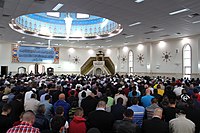
Back الإسلام في أستراليا Arabic Avstraliyada islam Azerbaijani অস্ট্রেলিয়ায় ইসলাম Bengali/Bangla اسلام در استرالیا Persian Islam en Australie French Islam di Australia ID Islāms Austrālijā Latvian/Lettish Islam di Australia Malay آسٹریلیا وچ اسلام PNB Ислам в Австралии Russian
| Part of a series on |
| Islam in Australia |
|---|
 |
| History |
|
| Mosques |
| Organisations |
| Islamic organisations in Australia |
| Groups |
| Events |
| National Mosque Open Day |
| People |
| Islam by country |
|---|
 |
|
|

Islam is the second largest religion in Australia. According to the 2021 Census in Australia, the combined number of people who self-identified as Muslims in Australia, from all forms of Islam, constituted 813,392 people, or 3.2% of the total Australian population.[1][2] That total Muslim population makes Islam, in all its denominations and sects, the second largest religious grouping in Australia, after all denominations of Christianity (43.9%,[3] also including non-practicing cultural Christians).
Demographers attribute Muslim community growth trends during the most recent census period to relatively high birth rates, and recent immigration patterns.[4][5] Adherents of Islam represent the majority of the population in Cocos (Keeling) Islands, an external territory of Australia.[6]
The vast majority of Muslims in Australia are Sunni, with significant minorities belonging to the Shia denomination. The followers of each of these are further split along different Madhhab (schools of thought within Islamic jurisprudence for the interpretation and practice of Islamic law) and Sub-Sect. There are also practitioners of other smaller denominations of Islam such as Ibadi Muslim Australians of Omani descent, and approximately 20,000 Druze Australians whose religion emerged as an offshoot of Islam which arrived in Australia with the immigration of Druze mainly from Lebanon and Syria. There are also Sufi (Islamic mysticism) minorities among Muslim practitioners in Australia.[7]
While the overall Australian Muslim community is defined largely by a common religious identity, Australia's Muslims are not a monolithic community. The Australian Muslim community has traditional sectarian divisions and is also extremely diverse racially, ethnically, culturally and linguistically.[8] Different Muslim groups within the Australian Muslim community thus also espouse parallel non-religious ethnic identities with related non-Muslim counterparts, either within Australia or abroad.[9]
- ^ "Australian Bureau of Statistics : 2021 Census of Population and Housing : General Community Profile" (XLSX). Abs.gov.au. Retrieved 2 July 2022.
- ^ "2071.0 - Reflecting a Nation: Stories from the 2011 Census, 2012–2013". 21 June 2012. Retrieved 15 December 2014.
- ^ "2071.0 - Census of Population and Housing: Reflecting Australia - Stories from the Census, 2016". www.abs.gov.au. Archived from the original on 20 September 2017. Retrieved 11 January 2022.
- ^ "Old trend no leap of faith". The Sydney Morning Herald.
- ^ "Australians Lose Their Faith". The Wall Street Journal.
- ^ Athyal, Jesudas M. (2015). Religion in Southeast Asia: An Encyclopedia of Faiths and Cultures: An Encyclopedia of Faiths and Cultures. Santa Barbara, California: ABC-CLIO. p. 42. ISBN 978-1610692502.
- ^ J. Gordon Melton; Martin Baumann (21 September 2010). Religions of the World: A Comprehensive Encyclopedia of Beliefs and Practices. Abc-Clio. p. 247. ISBN 9781598842043.
- ^ Burke, Kelly (22 September 2012). "Disunity, not anger, is Muslim dilemma". The Sydney Morning Herald. Retrieved 12 April 2015.
- ^ Baker, Jordan; Marcus, Caroline (23 September 2012). "Inside Sydney's City of Imams". Sunday Telegraph. Retrieved 7 April 2015.
© MMXXIII Rich X Search. We shall prevail. All rights reserved. Rich X Search